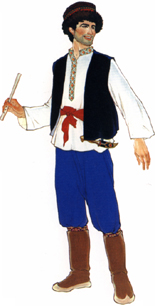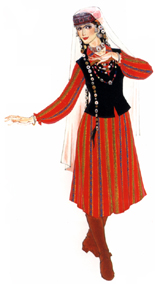|
Tajik's Costume
( 2005-09-13 )
 There are over 33,000 Tajiks, the majority of who live in the Tajik Autonomous County in Northwest China's Xingjiang Uygur Autonomous Region. While still speaking their native tongue, they now use the Uygur script to write with. The Tajiks are followers of Islam. Animal breeding is their main occupation, and arable farming a supplement. They are famous for their embroidery, weaving, and appliqué (ornamental design on clothes) skills. The heroic eagle has a great symbolic meaning for the group. Tajik herdsmen play a flute made of the eagle's wing-bone that produces a particularly thrilling sound. There are over 33,000 Tajiks, the majority of who live in the Tajik Autonomous County in Northwest China's Xingjiang Uygur Autonomous Region. While still speaking their native tongue, they now use the Uygur script to write with. The Tajiks are followers of Islam. Animal breeding is their main occupation, and arable farming a supplement. They are famous for their embroidery, weaving, and appliqué (ornamental design on clothes) skills. The heroic eagle has a great symbolic meaning for the group. Tajik herdsmen play a flute made of the eagle's wing-bone that produces a particularly thrilling sound.
Tajik men wear a shirt, a collarless overcoat buttoned down the front, a long and wide colorful waistband, and loose trousers. In winter, they add a cloak made of sheepskin over the overcoat. Tajik men often hang a knife around their waist, which they consider handsome, especially when riding on horseback.
 The men often wear a round high-crowned hat made of black velvet with a turned-up brim. The hat has a velveteen surface and a black wool lining, and its brim can be pulled down to cover the ears and the face. The men often wear a round high-crowned hat made of black velvet with a turned-up brim. The hat has a velveteen surface and a black wool lining, and its brim can be pulled down to cover the ears and the face.
Tajik women wear one-piece dresses. Married women wear a large piece of embroidered cloth around the back of their waist; the cloth covers the entire butt. They wear a round-topped embroidered hat sewn with a back veil for keeping warm; when going out, they wear a long and wide handkerchief. Old women love to wear a white handkerchief, while brides have to wear red ones.
When going out, women cover the cap with a long, large veil, which covers the head, shoulders, and waist, with only the eyes, nose, and mouth exposed. Most women hang three to five strings of red beads or four to five silver coins on the veil.
All men and women wear felt socks and high soft boots made of wild goat hide with soles made of yak hide.
|

